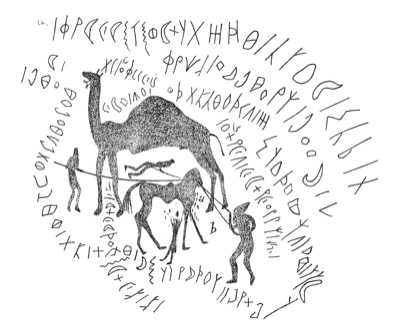Sigla: C 1186; Vogüé 389 b Script: Safaitic
Transliteration
l (m)ty bn s¹l bn mty bn ʿ(l)y ḏ---- f h gdʿwḏ s¹l(m) w l- -h h- mhrt yrbb -h (w) dmy l- -h s²m(t) w {h} lt l- ʾḫl w wk(s¹) w ḫrs¹ w ʿrg w ʿwr l- mn ḫbl
Translation
By {Mty} son of S¹l son of Mty son of {ʿly} of ---- and so O Gdʿwḏ [grant] security and to him [Mty] belongs the filly which he is training {and} {S²mt} drew [the picture] for him and {O} Lt let there be indeed failure and loss and dumbness and lameness and blindness on whoever obscures [the drawing and inscription]
Apparatus Criticus
C: s¹n for s¹l; yr----h w dmy f h s²m(s¹) "---- and he drew and O S²m(s¹)" for yrbb -h (w) dmy l- -h s²m(t) "which he is training and S²mt drew for him";
Commentary
The section of the text beginning f h gdʿwḏ is not connected to the section ending ʿ(l)y ḏ ----, but runs parallel with it and it is impossible that it belongs to C 1187.
The translation here of the section w l- -h h- mhrt yrbb -h (w) dmy l- -h s²m(t) was first proposed in Macdonald 1996: 74. There are other examples in Safaitic of asyndetic relative clauses following defined antecedents, a feature which also occurs in early Classical Arabic (Beeston 1970: 50, note 1). See Al-Jallad 2015: 188 for a discussion of this and other examples. For another inscription in which the author records that someone drew a picture for him see LP 325. Note that C 1188 which starts between the front legs of the camel and runs across C 1186 is by S²mt bn Mdʿ and is probably the artist's signature. The curse is one of the longest in the Safaitic inscriptions. The {h} in w {h} lt is entangled with the second bn of C 1188. On the asseverative l- before ʾḫl see Al-Jallad 2015: 160–161. We would suggest that ʾḫl is the verbal noun of the IV (afʿala) form of ḫalla "he fell short of accomplishing what he ought to have done" (Lane 778c), though for another possibility see Al-Jallad 205: 320. Following Al-Jallad 2015: 352 we would take as wk(s¹) as meaning "loss". The remaining afflictions are well attested in Safaitic.
Subjects
Genealogy
Prayer
Deity
Domestic animals
Drawing of a domestic animal
Curse
Country: Syria
Region: Rif Dimashq
Site: Riǧm Qaʿqūl
Latitude: 32.9764
Longitude: 37.3136
Present Location: In situ
Find date: 1861, 1862
Field collector: de Vogüé
Notes: The name "Rijm Qaʿqūl" was applied by nineteenth-century travellers to at least four large outcrops at the southern end of the Ruḥba, to the south and south-west of the modern water tower. This helps to explain the curious fact that there is no overlapping between the "Rijm Qaʿqūl" copies of de Vogüé, Wetzstein and Dussaud & Macler, and only in a very few cases between those of de Vogüé and Waddington who were travelling together. The probability that there were multiple cairns with this name is supported by the fact that that while Waddington wrote that it was 10 minutes [ride] from al-ʿUdaysīyah to Riǧm Qaʿqūl, Dussaud & Macler say that the journey between the two took 30 minutes. In 1995, the Safaitic Epigraphic Survey Programme identified the sites visited by Wetzstein and by Dusaud & Macler but did not find those where de Vogüé and Waddington had worked. The inscriptions found at Riǧm Qaʿqūl "A" were all texts copied by Wetzstein and no one else. It is likely therefore that this is the place he regarded as "Rijm Qaʿqūl". Note that the co-ordinates given here are very approximate.
Associated Drawings: A drawing showing the breaking in of a filly by four men, with a camel in the background
Associated Inscriptions: C 1185, 1187–1189
References:
Al-Jallad, A.M. An Outline of the Grammar of the Safaitic Inscriptions. (Studies in Semitic Languages and Linguistics, 80). Leiden: Brill, 2015. Pages: 160–161, 188, 320, 352
Beeston, A.F.L. The Arabic Language Today. London: Hutchinson, 1970. Pages: 50, n.1
[Vogüé] de Vogüé, M. Syrie Centrale. Inscriptions sémitiques. Paris: Baudry, 1868-1877. Number: 389 b
Lane, E.W. An Arabic-English Lexicon, Derived from the Best and Most Copious Eastern Sources. (Volume 1 in 8 parts [all published]). London: Williams & Norgate, 1863-1893. Pages: 778c
[LP] Littmann, E. Safaïtic Inscriptions. Syria. Publications of the Princeton University Archaeological Expeditions to Syria in 1904–1905 and 1909. Division IV. Section C. Leiden: Brill, 1943. Number: 325
Macdonald, M.C.A. Hunting, Fighting and Raiding: The Horse in Pre-Islamic Arabia. Pages 72-83, and plates on p. 222-225 in D. Alexander (ed.), Furusiyya. Volume I: The horse in the art of the Near East. Riyadh: King Abdulaziz Public Library, 1996. Pages: 74
[C] Ryckmans, G. Corpus Inscriptionum Semiticarum: Pars Quinta, Inscriptiones Saracenicae Continens: Tomus I, Fasciculus I, Inscriptiones Safaiticae. Paris: E Reipublicae Typographeo, 1950–1951.
URL of this record (for citation): http://krc.orient.ox.ac.uk/ociana/corpus/pages/OCIANA_0004609.html
